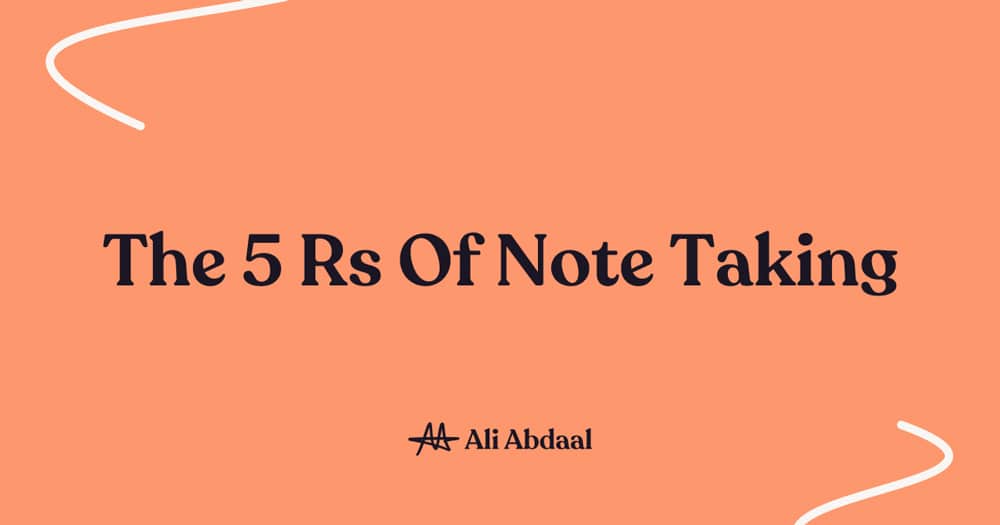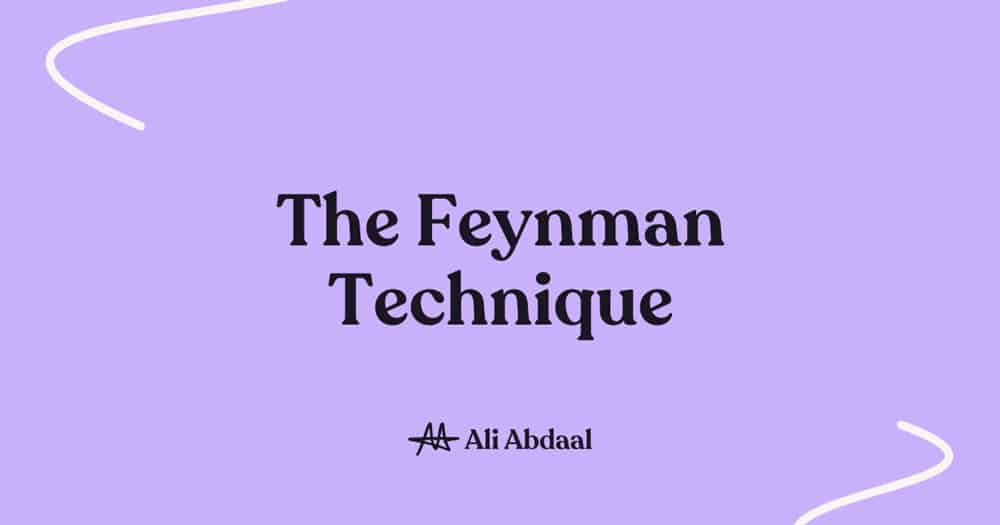The way we take our notes influences how well we learn. In short, a good note-taking technique is one that helps us remember, retain, and recall the most amount of information.
Clearly, there are a number of different ways we can take notes when learning stuff. Summarising, highlighting, and creating mind maps are just a few of the most popular methods. And to a large extent the ‘correct’ note-taking method is a very personal thing. If you’ve already found a technique that works for you, there’s really little point changing things. Do what works.
But, regardless of our preferred method, a good note taking + learning technique should have some easily identifiable characteristics. These essential characteristics are known as the 5 R’s of note taking:
- Record – there should be somewhere to take our notes (obviously).
- Reduce – there should be somewhere to summarise those notes.
- Recite – there needs to be an easy way to test ourselves using our notes.
- Reflect – our notes should be related to other notes we’ve already written.
- Review – we should regularly revisit our notes to ensure maximum retention.
✍️ The 5 R’s
1. Record
The most obvious aspect of any note-taking method is that we need somewhere to actually write our notes.
Whether we’re sat in a lecture, learning from a textbook, or following an online course (like my Part-Time YouTuber Academy), it’s important to have a blank page to write down all the meaningful points and ideas that you hear/read. Preferably, we should use no more than one piece of A4 paper to do this. Too much information makes it difficult to learn when we review it at a later date.
My advice is to use bullet points wherever possible as this helps to organise the notes coherently and helps us to scan for the most important information. Other things I’d suggest are:
- Use bold headings when moving on to a new point.
- Aim for telegraphic sentences (i.e. brief sentences).
- Leave as much white space as possible on the page to increase readability.
- Include abbreviations and symbols when writing stuff down. This is one of those seemingly minor note-taking tips that seriously helps when it comes to ramping up our learning speed. (If you’re typing your notes instead, then you may be interested in my video on ‘How I Type Really Fast’).
2. Reduce
Once we’ve written our notes, we need to summarise everything into our own words.
Summarising is a brilliant way of consolidating our understanding of the information, helps us to see where there are gaps in our knowledge, and there’s even some evidence to suggest it strengthens our memory. At the very least, by condensing our notes we’re essentially stripping away any information that isn’t 100% essential for us to know.
A lot of people will skip this crucial step thinking “I won’t forget this stuff” or “I’ll just summarise it later”, but these thoughts just make our lives so much harder when it comes to revising it later. I find it’s best to summarise everything straight after I’ve learnt it, so the material is still fresh in my mind. But don’t worry if it takes you a day or two to get this step done.
Another helpful tip is to reduce our notes by creating a bunch of questions that we can test ourselves on later. These questions should be focused on the main ideas that we’re learning rather than the nitty-gritty details, because the purpose is to ensure we understand the general arguments/points for each topic.
I talk about this more in my article on Active Recall, but the idea is that self-testing makes revision cognitively demanding as we have to try even harder to retrieve the information we want. This sounds counter-intuitive, but research shows that this helps our brain to better store and recall that same information in the future.
3. Recite
Recitation involves explaining everything we’ve learnt aloud, in as much detail as possible, without looking at our notes.
The process here is similar to the Feynman technique, which encourages us to identify knowledge gaps by explaining a topic as if we’re speaking to a small child. By doing this, we can’t hide from what we don’t know. If we struggle to explain something, we receive instantaneous feedback that we don’t understand the topic well enough. And, therefore, we’ve got to go back to our notes and learn them a little more.
Recitation is also far more beneficial than passively reading our notes (a common learning strategy for many students). The reason: reciting our notes helps transfer the information more effectively from our short-term memory to our long-term memory.
In one study, students were split into two groups and given 7 minutes to read a text. After a short break, the first group was told to repeat the exercise while the second group tried to recall as much information as possible from memory (i.e. recitation). A week later both groups were tested on what they’d learnt. The results were pretty incredible:
- 40% of the read-only group answered the questions correctly.
- 61% of the ‘recitation’ group answered the questions correctly.
Put another way, the simple act of reciting everything we know about a topic helps us to remember and retain more information.
“If you read anything over twenty times, you will not learn it by heart so easily as if you were to read it only ten, trying to repeat it between whiles, and when memory failed, looking at the book” – Francis Bacon
4. Reflect
Our brains remember information by associating new knowledge with the stuff we already know. So by reflecting on the things we’ve learnt previously and connecting those facts/ideas/experiences to our most recent notes, we’re giving ourselves the best chance to learn.
I’ve personally found that reflection is not just a retrospective process. By also reflecting on what we’re going to learn in the future it makes it a lot easier to incorporate and understand that new knowledge when we eventually come to learn it.
As a result, I like to reflect in three different ways:
- Build scaffolding – I make a few notes before I start writing my notes to think about what I already know about the topic (i.e. backward thinking reflection).
- Make predictions – I write a sentence about what new knowledge I may learn at some point in the future (i.e. forward thinking reflection). Basically, I make a prediction as to the sort of topics or information that may be relevant and connected to what I’m learning about right now that I haven’t directly learnt about before.
- The big picture – I try to think about how my notes relate to the big picture (i.e. present thinking reflection). The best way to do this is to write down 2-3 topics that are similar and write down any areas that confused me, which then acts as a springboard for further research and learning.
5. Review
Finally, we should spend 15 minutes at the end of each day to ‘review’ the notes we’ve written. This is the only reliable way to avoid knowledge decay.
The truth is, our knowledge has a half-life. This means that everything we know has an expiration date, and we’ll forget the information we don’t regularly revisit. So scheduling time for distributed review of our notes (i.e. regularly reviewing our notes rather than, let’s say, cramming it the night before a test) better encodes that knowledge into our long-term memory.
This is something I talk about in more detail in the following video, so check it out if this sort of stuff interests you:
📝 Implementing the 5 R’s
Now we know the characteristics of effective note-taking, we need a seamless way of integrating them together into a single strategy. This is where the Cornell Method comes in handy.
The Cornell Method of taking notes was created by the director of Cornell University’s ‘Reading & Study Skills Center’, Walter Pauk. In his book, How to Study in College, he says that the reason we often struggle to take effective notes is because doing so requires work – we need to put in the time to actively engage with what we’re learning about.
But this isn’t something that most of us find particularly fun or intuitive.
Luckily, the Cornell Method is a guided strategy for actively engaging with what we’re learning, by building the 5 R’s of note-taking directly into it.
The Cornell Method
Using this note-taking method is pretty straightforward. All we have to do is divide a single page of A4 into four sections:
- The right column – this is where we write our main notes from the lecture, video, or textbook. Here we are focused on RECORDING the meaningful points and ideas.
- The left column – this is where we write down any comments about what we’re learning (like if we agree/disagree) and jot down the key ideas discussed. I also like to use this section to write questions that test the most important pieces of knowledge, then use them as the starting point for RECITING what I remember.
- The bottom row – at the bottom of the page, we REDUCE our main notes into a few bullet points that summarise everything into our own words.
- The top row – other than writing the topic (e.g. anatomy) and date (e.g. 25/06/2025), I use the top row to REFLECT on the things I’ve previously learnt. This mainly involves finding 2 or 3 related topics I’ve written using the Cornell Method and listing them in the corner of the page. This helps to create a web of knowledge, which I then use to REVIEW multiple topics.
👋 Conclusion
Learning effectively begins with effective note-taking. And one of the best ways to take effective notes is by using a method that incorporates the 5 R’s.
For me, the Cornell Method is the easiest method of doing this.
- Firstly, we get a clear, organised, and coherent set of notes.
- Secondly, each section of the page serves a unique purpose, helping us to record, reduce, recite, reflect, or review.
But, having said that, the Cornell Method is just one of my many strategies I use for learning. If you’re interested in finding out more well-kept secrets on how to study effectively, then I’d love for you to watch my class below.



